Contributed by Sharon Butler / The pioneers of abstraction — the Cubists, the Abstract Expressionists, the Minimalists — emerged from firm and identifiable aesthetic roots and developed their own philosophies. In the competitive maelstrom of 20th century art, those philosophies became dogmas, and the dogmas outright manifestos. In the new century, many abstract painters are saying goodbye to all that didactic thinking and exuding a kind of calculated tentativeness. Raphael Rubinstein, in a 2009 Art in America essay and for a 2011 painting exhibition he curated in London, dubbed this new type of abstraction “provisional painting.” Similarly, artist and critic Stephen Maine homed in on the “incipient image” in a March 2011 show he curated at Lesley Heller. And the Brooklyn curatorial team Progress Report (aka Kris Chatterson and Vince Contarino) styled its survey of contemporary abstraction at the Bronx River Art Center The Working Title. All three labels suggest the centrality of the open proposition in contemporary abstraction.
There is a studied, passive-aggressive incompleteness to much of the most interesting abstract work that painters are making today. But the subversion of closure isn’t their only priority. They also harbor a broader concern with multiple forms of imperfection: not merely what is unfinished but also the off-kilter, the overtly offhand, the not-quite-right. The idea is to cast aside the neat but rigid fundamentals learned in art school and embrace everything that seems to lend itself to visual intrigue — including failure. The painters take a meta approach that refers not just to earlier art historical styles, but back to the process of painting itself. These self-amused but not unserious painters have abandoned the rigorously structured propositions and serial strategies of previous generations in favor of playful, unpredictable encounters. Pervading the work of artists like Lauren Luloff, Cordy Ryman, Amy Feldman, and Joe Bradley is an enervated casualness that may at first recall sophomore-year painting class.
If this sounds disparaging, it’s not meant to be. By reassessing basic elements like color, composition, and balance, based on 1920s-vintage Bauhaus principles taught in every 2-D foundations course, the new painters are exploring uncharted territory. They are looking for unexpected outcomes rather than handsome results. Dashing our expectations of “good painting,” painters like Martin Bromirski, Patricia Treib, Patrick Brennan, Jered Sprecher, and Keltie Ferris have challenged their validity and thus moved painting in a direction that requires a different way of looking. If a painting seems lousy, perhaps with a poorly constructed support and amateurish paint handling, look again.
Some painters focus on developing a style and spend 20 years refining it. These new abstract painters, on the other hand, are restless, their thrust less intensive and more expansive. Artists like Rochelle Feinstein and Chris Martin (whose first museum solo opens at the Corcoran on June 18) combine non-art materials in their paintings just for the hell of it, work at different scales, employ different color combinations, and experiment with unusual ways of applying paint. With less investment in honing a unique visual language, painters like Kadar Brock, Rebecca Morris, and Jasmine Justice use earlier forms of abstraction the way Rauschenberg used found objects. In the process, there is no room for handwringing about originality; it is simply assumed that it will result from synthesis and recombination. And if it doesn’t, well, isn’t that just as interesting?
Insofar as the new abstract painters employ old tropes and methods with a certain insouciant abandon, one might call them the new casualists. Yet they are not as iconoclastic as they might appear. In Malevich and the American Legacy, a recent exhibition at Gagosian, curator Andrea Crane attempts to position Malevich’s Supremetism as a progenitor of Minimalism. But in my view, Malevich’s small-scale, quirky abstractions have more in common with the new casualism than the austere, highly refined minimalism of Judd, Stella, Kelly, and the like. Malevich believed that pure feeling was to be found in non-objective painting, and that materialism could lead to “spiritual freedom.” Both Malevich and the new casualists, who approach their work intuitively, are unfazed by ill-defined parameters or truncated lines of thought. Like the philosopher-mathematicians who devised “fuzzy logic,” new casualists, like Suprematists, seek to accommodate a world in which there is often no clear truth or falseness. On balance, they are more intrigued by the questions and contradictions in art than by any definitive answers it might provide.
At Jason McCoy, Stephanie Simmons curated 70 Years of Abstract Paintings: Excerpts, which comprises a good survey of small-scale work by more than 40 artists. The exhibition presents a convincing historical context for the new post-Bauhaus abstraction. Old paintings by Josef Albers, Gene Davis, Jackson Pollock, Al Held, Man Ray, Hedda Sterne, Hans Hofmann, Leon Polk Smith, and Friedel Dzubas are hung side-by-side with recent work by Jim Lee, Joe Fyfe, Rob Nadeau, Sharon Horvath, Cora Cohen, Gwenn Thomas, and Thomas Nozkowski, among others. For most of the artists, their experience of everyday life is the filter through which they focus their paintings, entertaining multiple contradictory ideas at once. Although many of the artists included in the exhibition also work larger, Simmons selected small-scale work so that she could fit as much as possible into the show without marginalizing the smaller pieces. Tellingly, the smaller paintings tend not to be studies for larger work; rather, she told me, “working at different scales is one way they avoid a formulaic approach.”
If the new casualism resists evaluation on traditional criteria, how should it be judged? Here, perhaps, the Minimalists are relevant. Ellsworth Kelly once said, “I have never been interested in painterliness — putting marks on a canvas. My work is a different way of seeing and making something which has a different use.” A new casualist might well make the same general claim. But while Kelly wants to take the personal out of the equation, the casualist believes that exploring even mundanely subjective perceptions can yield extraordinary insights. In many ways, the new approach to abstraction is indebted to female artists of the 1970s like Elizabeth Murray, Mary Kelly, and Ree Morton, who, railing against the macho posturing of the Minimalists, worked from an intimate point of view that embraced messy everyday detail. The new casualists are adapting a like attitude to an increasingly complex, unfamiliar, and multivalent world. If the viewer leaves a show of their paintings agitated by their abrupt shifts, their crosscurrents, and their purposeful lack of formal cohesion, the work has succeeded.
——-
NOTE: This article originally appeared in The Brooklyn Rail.
Related posts:
Greetings from Nudashank
Quick Study: Melissa Meyer, Llewyn Davis, forgery and Casualism
By Any Other Name: Casualism at DODGE
July 18: Panel discussion on Casualism (and other forms of abstraction)
Weekend report: Casualism’s heredity, visit to The Brooklyn Museum,Museum Hours, studio update
The backstory: Supports/Surfaces survey at CANADA



























Mixed feelings, in one sense I like the anti monumental posing that leaves a kinda corporate free innocence to the imagery. On the other hand parodying minimalist pared down seriousness with casual simplicity can come very close to simple-mindedness, if not tedium; one Amy Feldman is fine, a group of starts to look like a running away from challenging content, like the queerying that saves much of Keith Haring's work. Ultimately, I feel for these painters as they don't seem to believe in their motifs, as if they are in a holding pattern until the Ah Ha moment comes. I don't think nyptg is in a decline, but …
Sharon,
I found your article on Abstract Painting: The New Casualists worthy of note, if only for the frustration it caused. By asking if the half-hearted semi-failure of much new abstract painting isn�t �just as interesting� as any stereotypical success, you end up endorsing all its wanton lack of originality. You think that in the deconstructing and re-combining of all the worn-out old modernist tropes there is some original stuff happening? I don�t think so; it all looks horribly familiar to me. And pretty feeble. And even if it�s true that this art is of interest, isn�t �interesting� – in the case of painting – damning it with faint praise? Don�t we want more of art?
I�d go part way along with you, in as much as I absolutely agree that abstract painting has to get over the iconic works of the last century and discover some new territory. And I would also say that the kind of painting you are talking about is marginally preferable to the other recent trend of yet more painting with a subject-matter of �painting� (yawn). But no-one is going to achieve anything really new by being laid back, cool and casual about it, or by being ironic about their involvement in it. Such posing makes for good copy, but that�s about all.
So the frustrating bit is that despite being able to agree with you that something new is needed, you seem at the moment to be writing your own dogma in support of the second-rate. I believe there is a great future for abstract art. Perhaps it will have nothing to do with modernism.
Kind regards,
Robin Greenwood
Director
Poussin Gallery
Block K
13 Bell Yard Mews
175 Bermondsey St
London SE1 3UW
020 7403 4444
mail@poussin-gallery.com
http://www.poussin-gallery.com
P.S. Could we put your article on http://www.abstractcritical.com ?
There's a few things I relate to here and,…there. Starting chronologically as they were discovered in my own research.
Taken from Joan Miro': Painting & Anti-Painting and also quoted in Rubinstein's Provisional Painting; "I can't bear to have it there in front of me…[When] I've finished something I discover it's just a basis for what I've got to do next. It's never anything more than a point of departure." – Miro
Simply stated, but direct nonetheless, the idea lends itself to an excerpt in Rubinstein's essay �Provisional Painters�; "Restless painters tend to work in several different manners at once or embark on new approaches in serial order."
Two paragraphs later Rubinstein describes a difference between the historical "bad painting" and his conceptual model of the provisional. Rubinstein uses Joe Bradley's "Schmagoo Paintings" for example, saying, "Their work may at times come off as uncertain, incomplete, casual, self-cancelling or unfinished, but each of them is fully committed to the project of painting. If they seek to break existing, perhaps unspoken, contracts with painting, it is only in order to draw up other protocols that will renew the medium." This for one clearly distinguishes a difference between Miro's project of Anti-Painting, which claims to "destroy everything that exists in the realm of painting," and again from the '70's rooted "bad painting," who's anti-aesthetic allows for individual freedom outside the traditions historical clich�.
With the exception of Rubinstein�s essay, I wondered if a section of Mira Schor's "Modest Painting" in her book "A Decade of Negative Thinking," was a better jumping off point for "The New Casualists" theory. After all Schor never brands this type of work in the essay. She only distinguishes it as something happening outside the modest and the abject. Worded similarly in the opening paragraph of this post, Schor vaguely describes this observation as an "overall aesthetic position demonstrating the loss of belief or lack of interest in participating disciplines or intellectual "isms."
Does the proposed "New Casual" aesthetic exist outside the modest and the abject? If so how does the work distinguish itself from Rubinstein�s Provisional Painting? In light of the latter, this new aesthetic must consist not only of restlessness, uncertainty and self-cancelation, but also negate "modesty" in the form of commodity (hence the "enervated casualness that may at first recall sophomore-year painting class."). Consider Tworkov�s quote in Schor's "Decade of Negative Thinking.�
"What will an artist not do for attention – even having his or her behind bared when that was still a novelty. But even modesty is sometimes no more than a ploy. And the mien of utter integrity is sometimes no more than a mask for frustration." – Tworkov
My question is how does �The New Casualist" aesthetic differ from the Provisional Painter. If there is a clear distinction, in what form does it exist, specifically? Formal, metaphorical, political or through the canon of minimalism?
I associate directly with many intellectual relationships in your writing and with those linked. My work is, with all respect "restless,' hence my interest in tracking and tracing these ideas with similar artists experiences. If what was said earlier in the Twitter conversation between @TwoCoats and @Powhida is true, and facture is the defining aspect distinguishing the casual from provisional, modest and abject, then how should it be sought out specifically and identified?
Thanks for your efforts and active engagement with painters and painting!
is early rauschenberg an old casualist?
http://artobserved.com/artimages/2010/11/RobertRauschenbergShortCircuitCombine-Painting1955GagosianGallery1-e1288983902776.jpg
thanks for your interesting article(s).
i enjoy your blog very much.
cheers
"… no-one is going to achieve anything really new by being laid back, cool and casual about it, or by being ironic about their involvement in it."
I guess we need to know then, what is the pose or position one should take? Railing expressionist condemning the incessant proliferation of capitalism, while selling to the very same capitalists? If you take a long view of this, the situation of casualness is normal. Cimabue or Duccio in the Trecento were restricted to what they could paint, an enthroned and etherialized Madonna and child with x amount of gold leaf and x amount of lapus lazuli. Two centuries later this doxia has been tranquilized and one witnesses Titiano displaying a native Italian girl as Mary totally corporalized and sexual. We are let's say 50 years out of the above artists doing a caricature of Al Held. The minimalist's zealotry to form, surface and color is gone and we could say we are witnessing what Kubler called 'stylistic drift'. One could say American painting was in that state prior to Abx, and even that grouping had all kinds of variants. Rothko and Newman look nothing like DeKooning. The situation also reminds me of the moment just prior to the over hyped promotion of the East Village Neox 'movement'. So, hang on, casual will give way to someone's rage. One other thing, the painting situation is similar to the indie/alternative music category, it's all over the place with a Tune yard being nothing like a Yeasayer, St. Vincent, even more distant to the masters like Radiohead. And, no guitar hero.
Hi Sharon,
I like the term "casualists" and much else in your article. There certainly is a lot of nonchalant abstraction around, in this country and in Europe; so much more than when I published my article. The question is "why?" I am working out my theories in another essay. I know some of the work you discuss, but some not. I didn't see the Jason McCoy show, though it included a painter I like a lot who hasn't got the attention he deserves–Christopher Deeton. I'm not sure about "passive-aggressive" but I will certainly think about it. I like "unexpected outcomes rather than handsome results" and your citing of women artists of the 1970s as an important precedent.
Have you seen the Kimber Smith show?
Best,
Raphael Rubenstein
John Yau wrote a good Press Release for the Broken/Window/Plane show he organized at the Tracy Williams Gallery in NYC opening Feb. 16th. He calls for a new openness. "Painters � the best ones, anyway � have long found ways to supersede the received wisdom regarding painting�s identity." Thanks Sharon for another enlightening article.
Hello Sharon
Enjoyed the article, Its definitely in the air and nice to see someone writing about this, just thinking of the context,perhaps Ryman, Heilman, digital mash ups, surrealism, outsider art, mannerism, and the sheer mutability of paint come to mind.
Mark Joyce
Dublin